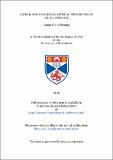Linear and nonlinear optical properties of silica aerogel
Abstract
Scattering media have traditionally been seen as a hindrance to the controlled transport of
light through media, creating the familiar speckle pattern. However such matter does not cause
the loss of information but instead performs a highly complex deterministic operation on the
incoming flux. Through sculpting the properties of the incoming wavefront, we can unlock the
hidden characteristics of these media, affording us far more degrees of freedom than that which is
available to us in traditional ballistic optics.
These additional degrees of freedom have allowed for the creation of compact sophisticated
optical devices based only on the deterministic nature of light scattering. Such devices include
diffraction-limit-beating lenses, polarimeters, spectrometers, and some which can transmit entire
images through a scattering substance.
Additional degrees of freedom would allow for the creation of even more powerful devices,
in new working regimes. In particular, the application of related techniques where the scattering
material is actively modified is limited.
This thesis is concerned with the use of optothermal nonlinearity in random media as a way to
provide an additional degree of control over light which scatters through it. Specifically, we are
concerned with silica aerogel as a platform for this study.
Silica aerogel is a lightweight skeletal structure of silica fibrils, which results in a material which
is up to 99.98 % by volume. This material exhibits a unique cocktail of properties of use such as near
unitary refractive index, an order of magnitude lower thermal conductivity, and high optothermal
nonlinearity. The latter two of these properties allow for the creation of localised steep thermal
gradients, proportionally affecting the low refractive index significantly. Additionally through
differing fabrication steps, the opacity, and as a result, we can adjust the scattering strength.
In line with the development of light deterministic light scattering techniques in linear media,
we develop through the use of pump-probe setups, a framework for the development of a similar
line of techniques in nonlinear scattering media. We show that we can reversibly control the
far-field propagation of light in weakly scattering silica aerogel. Following this, we show that
nonlinear perturbation can be used to extend and modify the optical memory effect, where slight
adjustments in scattering direction maintain the overall correlation of the scattered profile. Finally,
we measure the nonlinear transmission matrix, a complete description of how any wavefront would
pass through at a particular point in a scattering media, and how that scattering can be modified
through the application of an optothermal nonlinearity.
Extending the tool of scattering media into the nonlinear regime helps pave the way toward the
next set of advances in the field of light scattering control.
Type
Thesis, PhD Doctor of Philosophy
Collections
Description of related resources
Linear and nonlinear optical properties of silica aerogel (Thesis data) Fleming, A., University of St Andrews, 9 August 2019. DOI: https://doi.org/10.17630/906a13bf-413d-472e-b479-15e50b441994Related resources
https://doi.org/10.17630/906a13bf-413d-472e-b479-15e50b441994Items in the St Andrews Research Repository are protected by copyright, with all rights reserved, unless otherwise indicated.

